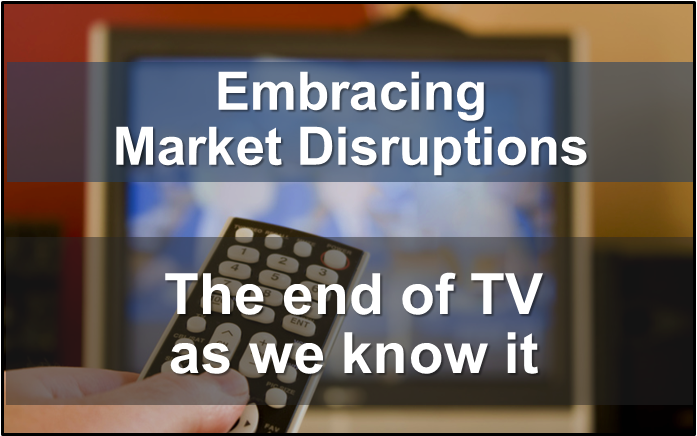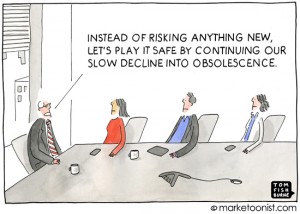Many products, especially technology products, are marketed as revolutionary or game-changing. Most people know better than to trust marketers at face value on claims like these.
Disruptions to the market could be defined as those who alter the balance of an industry between supplies, consumers, existing and new competitors and alternatives – Porter’s five forces. These changes alter the industry’s profitability, growth rates and expectations for future growth.
Examples of true disruptions include when streaming TV and movies over the Internet (Netflix, Hulu) became a viable alternative to in-store rentals (RIP, Blockbuster) or when computer components enabled smaller companies (Dell) to compete at lower costs than industry leaders (IBM, HP).
Market leadership is not powerful enough to stop market disruptions
In the majority of cases, the new technology was available to industry leaders who chose to disregard it as a fad or inferior to their existing technology. There were clear signals of the market disruption, which leaders chose to ignore.
Sony ignored the digital music revolution, allowing Apple to dominate the market with the iPod and iTunes. Sony had everything to win: the company invented portable music with the Walkman a few decades ago. Sony owns movie and music publishers and distributors. Sony produces consumer electronics, computers, and mobile phones. The company’s mission is to innovate around content to deliver new experiences. And yet, Sony chose not to participate in the disruption.
In 1974 Steve Sasson, an engineer at Kodak, created the first digital camera by using a commercially available CCD sensor which Fairchild Semiconductor would sell to anyone. In an interview, Sasson said: “The revolution was going to happen, I didn’t know when, and I didn’t know how effective it would be. In the end result, the fundamental business model of Kodak was undermined by the new technology.”
The problem? Digital cameras did not require film, which was the core of Kodak’s business. The company deliberately chose not to participate in the new market (for some time) because it threatened its core business. Kodak tried to ignore the future. Kodak thought its industry leadership gave it enough power to stop the advances of technology, the change in consumer behavior and the power of truly disruptive technologies. Kodak was wrong.
Jeff Bezos said it best “Amazon isn’t happening to the book business. The future is happening to the book business“. (you may want read about the 7 principles behind the success of Bezos).
Pay TV is being disrupted today
The signals of a new market disruption are clear. History repeats itself in front of us and it is up for the broadcast industry to ignore or embrace: 47% of U.S. households subscribe to an internet TV or movie service, up from 24% just four years ago, according to a new study from the Leichtman Research Group
According to the consumer electronics association (CEA), 5 million U.S. TV households rely exclusively on internet TV, and 10 percent of all TV households said that they’re likely to cancel that service in the next 10 months. 17 million TV households use antennas and/or internet services instead of traditional pay TV services. About 100 million households subscribe to pay TV, down 7% from 2013 according to the research firm SNL Kagan.
Pay TV is an oligopoly today. The companies who benefit will try to slow down change or make small moves to participate in the market, but they so far lack the balls fortitude to disrupt the market themselves and compete with their own services in the new paradigm.
Lawyers Can’t Stop Disruptions
The very next day after the Supreme Court ruled against Aereo, a new TV streaming service, in a copyright lawsuit brought by the oligopoly of TV broadcasters, another company, Simple.TV, started promoting a new streaming service.
“If cable companies believe that their old ways of doing business are protected by the Aereo Supreme Court decision, they are clearly misguided, consumers are rejecting cable companies and traditional consumption models. The horse is out of the barn.” – Dan Nova, partner, Highland Capital Partners.
Tesla, who is clearly pushing to evolve the automobile market, is struggling with lawsuits and laws promoted by the old-school market leaders. New Jersey, Arizona, Maryland, Texas and Virginia ban the direct sale of cars to consumers. the theory is that dealerships protect consumers. The reality is the big automakers can’t compete effectively with Tesla and are looking at lobbying as a way to protect their obsolete model.
The end of TV as we know it
The writing is on the wall. Disruption is happening. Lawsuits may slow things down but the plug has been pulled from the bathtub. It is unstoppable. Broadcasters, publishers and others in this industry can exploit their current position and start planning for chapter 11 or they can embrace the new model and lead it.
Unfortunately, not all problems in the industry can be solved by disruptions. Some, like programming, are consequences of consumer behavior. I find it interesting that:
- One of the most trusted sources of news is Jon Stewart on Comedy Central
- MTV does not broadcasts music videos anymore
- Discovery channel is mostly science fiction (just do a search for ‘Discovery Megalodon hoax’ or ‘Sirens hoax’, which set a viewership record for Animal Planet in spite of misleading viewers about the fact it is pure fiction
- Honey BooBoo is one of the leading shows on the Learning Channel
- Swamp People and Pawn Stars are some of the star shows of The History Channel
Market disruptions are accelerated by abuses of their market power, which upset customers and make them far more interested in alternatives. Customer dissatisfaction with pay TV service is well documented.
There are some clear signs of industry leadership abuse that open the door to competitors:
- Having to wait a few weeks to get service
- Sitting at home for the better part of the day waiting for the technician to show up in the 6-hour ‘window’
- Paying $200 for TV service
- Extra fees for every TV, another extra fee for HD, ‘convenience fees’ and other dumb service fees (bad profits, as Fred Reicheld calls them)
- Having to wait for the next airing of a TV show we want to watch right now
- Waiting an hour to talk to customer service while listening to a message that tells us how valuable our call is and how much they love us
- Too many TV commercials, most irrelevant to us, which play at a higher volume than regular programming
- Not being able to watch a TV program on demand or via Roku/Hulu/etc. because the producer wants to ‘engage with customers directly’ on their own website (TLC, NFL, Formula 1 , etc.)
There is a reason why Comcast has the honor of being voted Worst Company in America. Time Warner Cable, Verizon and AT&T made finalists too.
Entrepreneurs will jump to opportunities to disrupt
The beauty of a market economy with a culture of innovation is that entrepreneurs will jump at the opportunity to fix problems in an industry. The definition of an entrepreneur is someone who sees opportunities where someone else see challenges – or abuses in this case.
Silvercar is a great example of a company that is challenging market leadership by challenging the accepted industry practices . I documented my experience with Silvercar in a recent post.
You don’t have to be a startup or a small company to challenge an industry status quo. T-Mobile has been positioning itself as the ‘un-carrier’ with great results: 1 million new subscribers in the last quarter and creating $8 billion in shareholder value in the process.

Who will disrupt your market?
The call to action is to understand the market disruptions in your market and get ahead of them. To identify the accepted practices in your industry that consumers hate and use them as opportunities to innovate and get ahead. To compete against your own company and cannibalize your own products. To be a driver of the industry instead of the road kill. This is your wake up call.
p.s. Update – For more information on the evolution of digital TV, I recommend looking at this very comprehensive presentation from Luma partners


